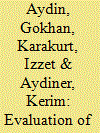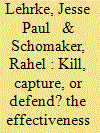|
|
|
Sort Order |
|
|
|
Items / Page
|
|
|
|
|
|
|
| Srl | Item |
| 1 |
ID:
098590


|
|
|
|
|
| Publication |
2010.
|
| Summary/Abstract |
CO2 emissions in the atmosphere are increasing continually, which are mainly originated from burning of fossil fuels. The fossil fuels are expected to remain a major component of the world's energy supply in the near future, because of their inherent advantages. Therefore, various measures have to be considered to reduce anthropogenic CO2 emissions. Increasing the efficiency of energy usage and/or developing lower carbon or non-carbon energies to replace high carbon fuels may bring the result of the reduction of the accumulation of CO2 in the atmosphere. The other alternative to reduce CO2 concentrations in atmosphere include gaseous storage in various deep geological formations, liquid storage in the ocean, and solid storage by reaction of CO2 with metal oxides to produce stable carbonates. In this article, the geological storage options of CO2 are examined. They are discussed in terms of applicability, cost, storage capacity and safety.
|
|
|
|
|
|
|
|
|
|
|
|
|
|
|
|
| 2 |
ID:
152822


|
|
|
|
|
| Summary/Abstract |
This article examines the effectiveness of contemporary counterterrorism strategy in the global fight against terrorism from 2001 to 2011. We seek to maximize the comparative approach more than most existing studies by examining three tactics (killing, capturing, and defending) applied at three scopes (leader, operational, and broad) on three levels (global, movement [jihadi], and organizational [al-Qaeda and Taliban]), while also measuring effectiveness along several quantitative, qualitative, and spatial dimensions. Drawing from resource theory (and its derived analytical approaches) and empirical terrorism studies, we formulate competing hypotheses that are quantitatively tested using a dataset with several original aspects. We find that both killing and capturing can have large effects but these effects vary based on both states' and terrorists' targeting strategies. The most interesting specific findings are that drone strikes seem counterproductive for counterterrorism while renditions seem effective. However, these effects were dwarfed by those of increased defenses, which reduce attacks in the West while redirecting them to other areas in the world. While we find the theory mostly sound, though in need of refocus, we believe current policy trends foretell an increase in terrorist activity in the coming years.
|
|
|
|
|
|
|
|
|
|
|
|
|
|
|
|
| 3 |
ID:
177365


|
|
|
|
|
| Summary/Abstract |
In early 2018, the U.S. Congress expanded the 45Q tax credit program for the capture, storage, and utilization of CO2. The 45Q tax credit expansion creates a financial incentive of $50 for each tonne of CO2 placed in long-term storage, a significant increase from the $20 per tonne that was originally authorized in the Energy Policy Act of 2008. Here, we estimate the net present value of industrial carbon capture and storage with the $50 per tonne credit and find that in some industrial systems, the costs of capturing, transporting, and storing one tonne of CO2 is less than $50. For systems in which the $50 tax credit is not cost effective, economies of scale associated with small emissions quantities are limiting, and a simple gaseous transportation solution which saves on CO2 compression costs improves economics in some cases. However, the $50 tax credit is unlikely to be sufficient to stimulate changes in the management of most industrial CO2 emissions.
|
|
|
|
|
|
|
|
|
|
|
|
|
|
|
|
|
|
|
|
|